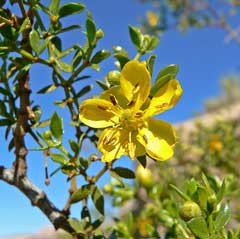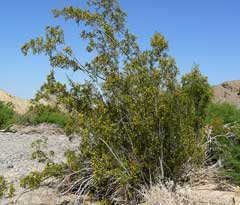 |
|
http://commons.wikimedia.org/wiki/User:Stan_Shebs |
 |
| http://commons.wikimedia.org/wiki/User:Stan_Shebs |
Translate this page:
Summary
Sometimes misspelt as Larrea tridendata
Physical Characteristics

 Larrea tridentata is an evergreen Shrub growing to 4 m (13ft 1in).
Larrea tridentata is an evergreen Shrub growing to 4 m (13ft 1in).
See above for USDA hardiness. It is hardy to UK zone 8. It is in leaf all year. The species is hermaphrodite (has both male and female organs).
Suitable for: light (sandy), medium (loamy) and heavy (clay) soils. Suitable pH: mildly acid, neutral and basic (mildly alkaline) soils. It can grow in semi-shade (light woodland) or no shade. It prefers moist soil.
UK Hardiness Map
US Hardiness Map
Synonyms
L. divaricata. L. mexicana. Larrea tridendata (incorrect)
Plant Habitats
Woodland Garden Sunny Edge; Dappled Shade;
Edible Uses
Edible Parts:
Edible Uses: Condiment Tea
The flower buds are pickled in vinegar and used as a caper substitute[183]. The stems and leaves are a tea substitute[183]. The twigs are chewed to alleviate thirst[2, 183]. A resin is obtained from the leaves and twigs, it delays or prevents oils and fats from becoming rancid[183].
References More on Edible Uses
Medicinal Uses
Plants For A Future can not take any responsibility for any adverse effects from the use of plants. Always seek advice from a professional before using a plant medicinally.
Expectorant Odontalgic Urinary
Creosote bush was widely used by various North American Indian tribes. A decoction of the leaves was used to treat diarrhoea and stomach troubles whilst the young twigs were used to treat toothache and a poultice of the leaves was used to treat chest complaints and as a wash for skin problems[254]. It continued to be widely used as a treatment for rheumatic disease, venereal infections, urinary infections and certain types of cancer, especially leukaemia until its sale was banned in North America due to concern over its potential toxic effect upon the liver[254]. There have been a number of cases of acute or sub-acute hepatitis attributed to the use of this herb and so its internal use is not recommended until further research has been carried out[254]. A tea made from the leaves is used as an expectorant and pulmonary antiseptic[213]. Some N. American Indian tribes heated the shoot tips of this plant and dripped the sap (probably the resin[K]) into tooth cavities to treat toothache[213].
References More on Medicinal Uses
The Bookshop: Edible Plant Books
Our Latest books on Perennial Plants For Food Forests and Permaculture Gardens in paperback or digital formats.

Edible Tropical Plants
Food Forest Plants for Hotter Conditions: 250+ Plants For Tropical Food Forests & Permaculture Gardens.
More

Edible Temperate Plants
Plants for Your Food Forest: 500 Plants for Temperate Food Forests & Permaculture Gardens.
More

More Books
PFAF have eight books available in paperback and digital formats. Browse the shop for more information.
Shop Now
Other Uses
References More on Other Uses
Cultivation details
Experimental Crop Industrial Crop: Hydrocarbon Management: Coppice
Requires a moderately fertile moisture-retentive soil in full sun or light shade[200]. This species is not hardy in the colder areas of the country, it tolerates temperatures down to between -5 and -10°c[200]. The plant is resinous and aromatic[200]. Carbon Farming - Cultivation: experimental. Management: coppice.
Carbon Farming
-
Experimental Crop
Plant breeders are testing these plants to see if they could be domesticated for cultivation, but they are still in an experimental phase. Examples include milkweed and leafy spurge.
-
Industrial Crop: Hydrocarbon
Materials, chemicals and energy include bioplastics, rubber, biomass products gasoline, jet fuel, diesel, butane, propane, biogas. Plants are usually resprouting plants and saps.
-
Management: Coppice
Cut to the ground repeatedly - resprouting vigorously. Non-destructive management systems maintaining the soil organic carbon.
References Carbon Farming Information and Carbon Sequestration Information
Temperature Converter
Type a value in the Celsius field to convert the value to Fahrenheit:
Fahrenheit:
The PFAF Bookshop
Plants For A Future have a number of books available in paperback and digital form. Book titles include Edible Plants, Edible Perennials, Edible Trees,Edible Shrubs, Woodland Gardening, and Temperate Food Forest Plants. Our new book is Food Forest Plants For Hotter Conditions (Tropical and Sub-Tropical).
Shop Now
Plant Propagation
Seed - we have no information for this species but suggest sowing the seed in a greenhouse in spring. When they are large enough to handle, prick the seedlings out into individual pots and grow them on in the greenhouse for at least their first winter. Plant them out into their permanent positions in late spring or early summer, after the last expected frosts. Cuttings of new growth in spring in a frame[200].
Other Names
If available other names are mentioned here
Native Range
NORTHERN AMERICA: United States (New Mexico, Texas, Arizona, California, Nevada (south), Utah (Washington Co.)), Mexico (Baja California (Norte), Baja California Sur, Chihuahua, Coahuila de Zaragoza, Durango, Nuevo León, San Luis Potosí, Sonora, Tamaulipas, Zacatecas, Aguascalientes, Hidalgo, Querétaro)
Weed Potential
Right plant wrong place. We are currently updating this section.
Please note that a plant may be invasive in one area but may not in your area so it's worth checking.
None Known
Conservation Status
IUCN Red List of Threatened Plants Status : This taxon has not yet been assessed

Growth: S = slow M = medium F = fast. Soil: L = light (sandy) M = medium H = heavy (clay). pH: A = acid N = neutral B = basic (alkaline). Shade: F = full shade S = semi-shade N = no shade. Moisture: D = dry M = Moist We = wet Wa = water.
Now available:
Food Forest Plants for Mediterranean Conditions
350+ Perennial Plants For Mediterranean and Drier Food Forests and Permaculture Gardens.
[Paperback and eBook]
This is the third in Plants For A Future's series of plant guides for food forests tailored to
specific climate zones. Following volumes on temperate and tropical ecosystems, this book focuses
on species suited to Mediterranean conditions—regions with hot, dry summers and cool, wet winters,
often facing the added challenge of climate change.
Read More
Expert comment
Author
(Sessé.&Moc. ex DC.)Coville.
Botanical References
200
Links / References
For a list of references used on this page please go here
Readers comment
© 2010, Plants For A Future. Plants For A Future is a charitable company limited by guarantee, registered in England and Wales. Charity No. 1057719, Company No. 3204567.